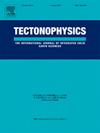利用密集线性地震阵列记录的环境地震噪声的自相关性对隐藏断层的地下位置进行成像
IF 2.6
3区 地球科学
Q2 GEOCHEMISTRY & GEOPHYSICS
引用次数: 0
摘要
环境噪声自相关函数(ACFs)可以在不需要有源或地震的情况下阐明单个地震台站下局部结构的体波反射率。然而,ACF中近零滞后时间的大振幅信号会干扰目标反射,从而阻碍了对浅层沉积物中隐断层精确定位的能力。在这项研究中,一个由30个三分量检波器组成的约1.2公里长的密集线性地震阵列与中国海南省的蒲谦-青兰断层正交,以成像断层周围的浅层结构。利用噪声记录的三个分量,我们计算了单个台站下的acf,然后从单个acf中减去平均源时间函数,得到体波反射率剖面。然后,我们使用200米/秒的恒定s波速度将零偏移反射率从时域转换到深度域。我们还通过叠加来自虚拟源集的附近迹线的互相关函数来分析零偏移反射率。结果表明,在~ 360 m剖面距离上,到基底的深度从~ 60 m突然增加到~ 110 m,这归因于濮前-青兰断裂的偏移作用。这一结论被一项工程地质研究所证实,从而表明本文使用的环境噪声技术可能对近地表基底结构成像特别有用。本文章由计算机程序翻译,如有差异,请以英文原文为准。
Imaging the subsurface location of a hidden fault using autocorrelations of ambient seismic noise recorded by a dense linear seismic array
Ambient noise autocorrelations functions (ACFs) can elucidate the body-wave reflectivity of the local structure beneath single seismic stations without the need for active sources or earthquakes. However, the large-amplitude signal of the near-zero-lag time in the ACF can interfere with the target reflection(s), thereby hindering the ability to determine the precise location of hidden faults in shallow sediments. In this study, a ∼ 1.2-km-long dense linear seismic array consisting of 30 three-component geophones was deployed orthogonal to the Puqian–Qinglan Fault in Hainan province, China, to image the shallow structure around the fault. Using three components of the noise records, we calculate the ACFs beneath single stations and then subtract the average source time function from the individual ACFs to obtain the body-wave reflectivity section. We then convert the zero-offset reflectivity from the time domain to the depth domain using a constant S-wave velocity of 200 m/s. We also analyse the zero-offset reflectivity by stacking the cross-correlation functions of nearby traces originating from virtual source gathers. The results reveal that the depth to basement increases suddenly from ∼60 m to ∼110 m at ∼360 m profile distance, which we ascribe to offset on the Puqian–Qinglan Fault. This conclusion is verified by an engineering geological study, thereby demonstrating that the ambient noise technique used here may be particularly useful for imaging the near-surface basement structure.
求助全文
通过发布文献求助,成功后即可免费获取论文全文。
去求助
来源期刊

Tectonophysics
地学-地球化学与地球物理
CiteScore
4.90
自引率
6.90%
发文量
300
审稿时长
6 months
期刊介绍:
The prime focus of Tectonophysics will be high-impact original research and reviews in the fields of kinematics, structure, composition, and dynamics of the solid arth at all scales. Tectonophysics particularly encourages submission of papers based on the integration of a multitude of geophysical, geological, geochemical, geodynamic, and geotectonic methods
 求助内容:
求助内容: 应助结果提醒方式:
应助结果提醒方式:


